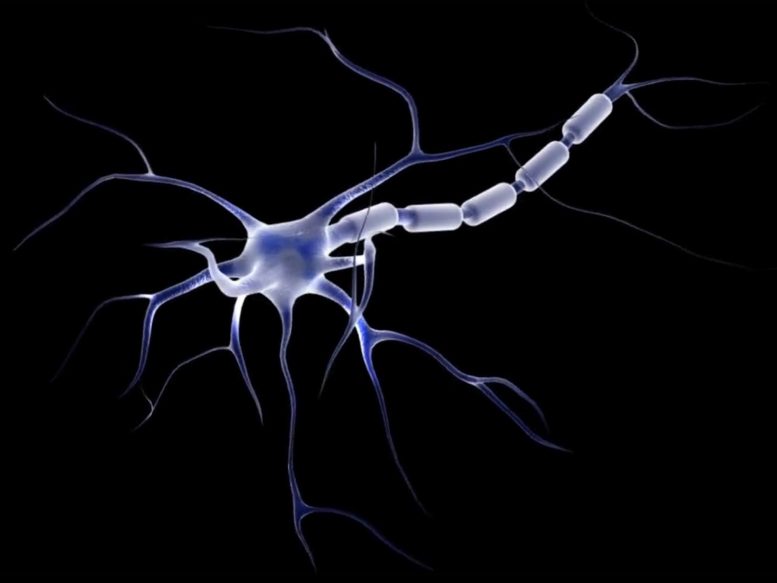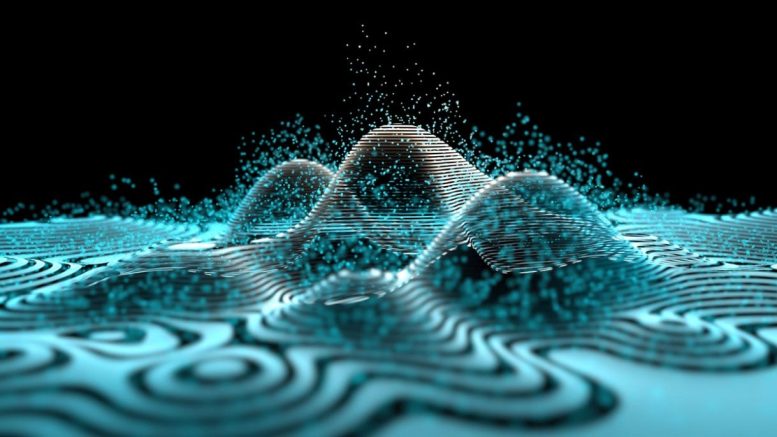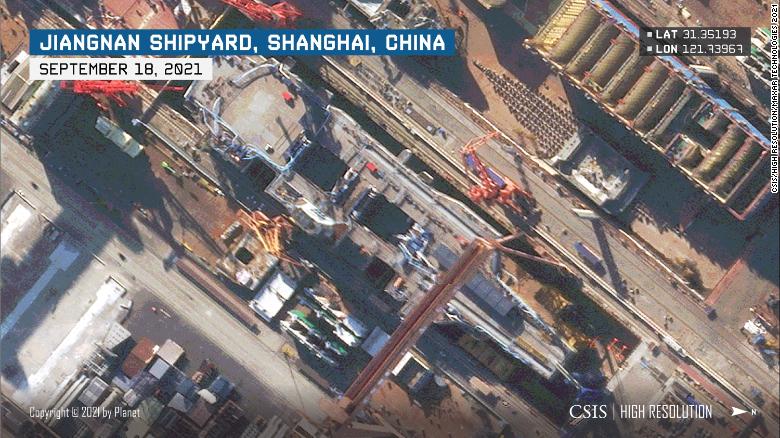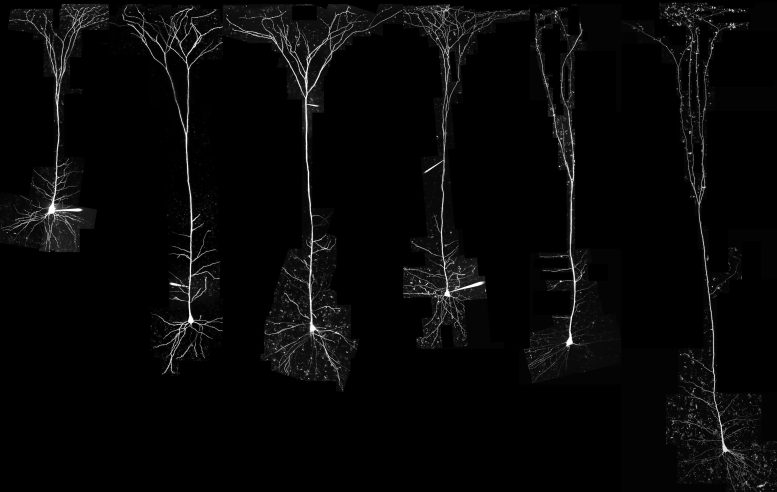Thursday, November 18
Human Neurons and Mammels

Human neurons have fewer ion channels, which might have allowed the human brain to divert energy
to other neural processes.
Neurons communicate with each other via electrical impulses, which are produced by ion channels that control the flow of ions such as potassium and sodium. In a surprising new finding, MIT neuroscientists have shown that human neurons have a much smaller number of these channels than expected, compared to the neurons of other mammals.
The researchers hypothesize that this reduction in channel density may have helped the human brain evolve to operate more efficiently, allowing it to divert resources to other energy-intensive processes that are required to perform complex cognitive tasks.
“If the brain can save energy by reducing the density of ion channels, it can spend that energy on other neuronal or circuit processes,” says Mark Harnett, an associate professor of brain and cognitive sciences, a member of MIT’s McGovern Institute for Brain Research, and the senior author of the study.
Harnett and his colleagues analyzed neurons from 10 different mammals, the most extensive electrophysiological study of its kind, and identified a “building plan” that holds true for every species they looked at — except for humans. They found that as the size of neurons increases, the density of channels found in the neurons also increases.
However, human neurons proved to be a striking exception to this rule.
“Previous comparative studies established that the human brain is built like other mammalian brains, so we were surprised to find strong evidence that human neurons are special,” says former MIT graduate student Lou Beaulieu-Laroche.
Beaulieu-Laroche is the lead author of the study, which was published on November 10, 2021, in Nature. READ MORE...
Wednesday, November 17
A True Story
Many years later, in 2013, the biological father was operating a bicycle shop in California when a writer/reporter came by and asked if he could talk to him. That was when the biological father, Ted Jorgensen, found out that his biological son is Jeff Bezos, the richest man in the world.
When Bezos exited the space capsule, the first person he hugged was his mother.
AMAZON founder Jeff Bezos sought the help of his parents to kick start his company back in 1995.
Since then, Amazon has become one of the top five wealthiest companies globally, with a net worth of over $314billion.
Jeff Bezos' parents were Jacklyn and Miguel 'Mike' Bezos.
Bezos, 57, was born in Albuquerque, New Mexico, to Jacklyn and Ted Jorgensen.
Jacklyn was 17-years-old when she gave birth to Bezos and was still a high school student at the time.
Bezos’ dad Ted owned a local bike shop in the city.
The pair divorced in 1965 and Jacklyn met Miguel “Mike” Bezos shortly after and fell in love.
She and Mike moved to Houston with Bezos and asked him to adopt her son when he was four years old.
Mike agreed and raised Bezos, even granting him his last name.
Mike came from a Cuban immigrant family and worked as an engineer for Exxon when he moved to the US.
How did Jeff Bezos’ parents help him with Amazon?
Bezos presented Mike and Jacklyn with the idea of Amazon back in 1995.
His parents lent him $245,573, which at the time was considered a large sum of money and a massive risk as the internet was fairly new.
Bezos turned $245,573 into $1trillion as of 2021 and is the world’s wealthiest person as of July 2021.
He is worth over $200billion.
Using the word UP
JUST TRY TO UNDERSTAND...
PHENOMENAL 2 LETTER WORD.
I'm sure you will enjoy this.
I never knew one word in the English language that could be a noun, verb, adj, adv, prep.
UP
Read until the end ... you'll laugh.
This two-letter word in English has more meanings than any other two-letter word, and that word is 'UP.' It is listed in the dictionary as an [adv], [prep], [adj], [n] or [v].
It's easy to understand UP, meaning toward the sky or at the top of the list, but when we awaken in the morning, why do we wake UP?
At a meeting, why does a topic come UP? Why do we speak UP, and why are the officers UP for election (if there is a tie, it is a toss UP) and why is it UP to the secretary to write UP a report? We call UP our friends, brighten UP a room, polish UP the silver, warm UP the leftovers and clean UP the kitchen. We lock UP the house and fix UP the old car.
At other times, this little word has real special meaning. People stir UP trouble, line UP for tickets, work UP an appetite, and think UP excuses.
To be dressed is one thing but to be dressed UP is special.
And this UP is confusing: A drain must be opened UP because it is blocked UP
We open UP a store in the morning but we close it UP at night. We seem to be pretty mixed UP about UP!
To be knowledgeable about the proper uses of UP, look UPthe word UP in the dictionary. In a desk-sized dictionary, it takes UP almost ¼ of the page and can add UP to about thirty definitions.
If you are UP to it, you might try building UP a list of the many ways UP is used. It will take UP a lot of your time, but if you don't give UP, you may wind UP with (UP to) a hundred or more.
When it threatens to rain, we say it is clouding UP. When the sun comes out, we say it is clearing UP. When it rains, it soaks UP the earth. When it does not rain for a while, things dry UP One could go on and on, but I'll wrap it UP, for now . . . my time is UP!
Oh . . . one more thing: What is the first thing you do in the morning and the last thing you do at night?
UP!
Did that one crack you UP?
Don't screw UP. Send this on to everyone you look UP in your address book . . . or not . . . it's UP to you.
Now I'll shut UP.
Our Twisted Universe

Hello, and welcome to November’s Lost in Space-Time, the monthly physics newsletter that unpicks the fabric of the universe and attempts to stitch it back together in a slightly different way. To receive this free, monthly newsletter in your inbox, sign up here.
There’s a kind of inevitability about the fact that, if you write a regular newsletter about fundamental physics, you’ll regularly find yourself banging on about Albert Einstein. As much as it comes with the job, I also make no apology for it: he is a towering figure in the history of not just fundamental physics, but science generally.
A point that historians of science sometimes make about his most monumental achievement, the general theory of relativity, is that, pretty much uniquely, it was a theory that didn’t have to be. When you look at the origins of something like Charles Darwin’s theory of evolution by natural selection, for example – not to diminish his magisterial accomplishment in any way – you’ll find that other people had been scratching around similar ideas surrounding the origin and change of species for some time as a response to the burgeoning fossil record, among other discoveries.
Even Einstein’s special relativity, the precursor to general relativity that first introduced the idea of warping space and time, responded to a clear need (first distinctly identified with the advent of James Clerk Maxwell’s laws of electromagnetism in the 1860s) to explain why the speed of light appeared to be an absolute constant. READ MORE...
Clocking Out
Before I started my company, I spent over a decade working for a nonprofit that I loved. It was a fantastic organization where amazing mentors and colleagues taught me much of what I know about the practical side of emotional intelligence.
Over the years I worked there, I put in my share of overtime. But as much I loved my job, I had a pretty strict routine of leaving work. On most days, I clocked out at 5 p.m.
But a funny thing happened once I started working for myself: The workdays got longer and longer, later and later. And while, yes, starting a company was hard, I'd soon learn that growing a company and maintaining it is pretty hard, too.
After realizing that I was working much more than I wanted to, I made a change. I like to call it, "the rule of clocking out." It's based on principles of emotional intelligence, the ability to identify, understand, and manage emotions.
I've found this rule helps me to set my priorities, keep everything in its place, and take control of my life. Here's how it works.How to set priorities, avoid burnout, and find more time in your day
When I first started my company, I was influenced by personalities like Mark Cuban, who says you have to outwork your competition, or they'll put you out of business. To be fair, I've learned a lot from Cuban over the years--but I didn't want to live life like him. My work is definitely a priority. But so is my family. And my mental health. And volunteering my time to help others.
Of course, one of the greatest things about being your own boss is you get to set your own hours. After realizing that I was working much more than I wanted to, I made a change. I would set a time every day to clock out. Then I'd treat that time like an important appointment, one that I can't miss.
The principles of clocking out apply especially well to business owners. But in reality, they provide value for anyone.For example, do you find that despite working later and later, there's always more work to get done?
Or that by focusing much of your energy on goals for your work or business, you forget about other priorities--like your mental or physical health?Or maybe you need to learn to clock out, not from work, but from something else that's draining your time and energy--like a clingy friend, or even a Netflix or YouTube addiction.
If any of the above applies to you, it can be difficult to change. This is likely because your emotions are ruling your habits, causing you to repeat the same routine.Here's where emotional intelligence comes in. TO FIND OUT WHAT THEY DO, CLICK HERE...
Moon Oxygen
In October, the Australian Space Agency and NASA signed a deal to send an Australian-made rover to the Moon under the Artemis program, with a goal to collect lunar rocks that could ultimately provide breathable oxygen on the Moon.
Although the Moon does have an atmosphere, it's very thin and composed mostly of hydrogen, neon, and argon. It's not the sort of gaseous mixture that could sustain oxygen-dependent mammals such as humans.
That said, there is actually plenty of oxygen on the Moon. It just isn't in a gaseous form. Instead it's trapped inside regolith – the layer of rock and fine dust that covers the Moon's surface.
If we could extract oxygen from regolith, would it be enough to support human life on the Moon?
Oxygen can be found in many of the minerals in the ground around us. And the Moon is mostly made of the same rocks you'll find on Earth (although with a slightly greater amount of material that came from meteors).
Minerals such as silica, aluminum, and iron and magnesium oxides dominate the Moon's landscape. All of these minerals contain oxygen, but not in a form our lungs can access. READ MORE...
Tuesday, November 16
Democracy and Censorship
I am retired from the workforce after 45 years
I am in my second marriage (if that really makes a difference)
I was born a Southern Tarheel
I currently live in East TN
In the 1960's, I attended college and while I was a flaming liberal in my heart, I was forced to listen to conservative points-of-view which despite the boredom had no impact on my thinking and beliefs at all. In the 1980's, I earned an MBA and allowed my newly found conservative beliefs to control my liberal mentality but my liberal mentality was not completely altered, just modified a tad.
My time in the military eventually persuaded me that it was my responsibility to protect any and all Americans who wanted to voice their opinions even if they did not agree with me... I believed that if an American wanted to burn the American Flag for whatever reason that they should be allowed the burn the American Flag... no, "if" "ands" or "buts"...
I am totally opposed from the government or our news media holding back information from the public... simply because they perceive that the public may not respond well... or that the information will lead the public to riot.
The public should be allowed access to all information even if a riot results... this is what it means to live inside a Democracy. Our government takes the good with the bad.
When the news media withholds information from the public because they do not want the public to know that information, it is even worse than the government holding back information from the public. If the public is uneducated or uninformed then they are incabable of making intelligent, educated decisions, and therefor must rely on others to make those decisions for them.
When that happens, we are no longer living in a democracy...
Building Self Esteem - Part II
 |
| Coffee beans are imperious to climate change... |
- Identify and Challenge Your Negative Beliefs. ...
- Identify the Positive About Yourself. ...
- Build Positive Relationships—and Avoid Negative Ones. ...
- Give Yourself a Break. ...
- Become More Assertive and Learn to Say No. ...
- Improve Your Physical Health. ...
- Take On Challenges.
- Conscientiousness - is the quality of wishing to do one's work or duty well and thoroughly
- Emotional Stability - means that you can withstand difficult situations, handle adversity, and remain productive throughout
- Extraversion - is a measure of how energetic, sociable, and friendly a person is
The desire to alter personality is not uncommon. Shy people might wish they were more outgoing and talkative. ... While self-help books and websites often tout plans you can follow to change your habits and behaviors, there is a persistent belief that our underlying personalities are impervious to change.
Strange Particles Called ANYONS

Researchers Show New Strategy for Detecting Non-Conformist Particles Called Anyons
By observing how strange particles called anyons dissipate heat, researchers have shown that they can probe the properties of these particles in systems that could be relevant for topological quantum computing.A team of Brown University researchers has shown a new method of probing the properties of anyons, strange quasiparticles that could be useful in future quantum computers.
In research published in the journal Physical Review Letters, the team describes a means of probing anyons by measuring subtle properties of the way in which they conduct heat. Whereas other methods probe these particles using electrical charge, this new method enables researchers to probe anyons even in non-conducting materials. That’s critical, the researchers say, because non-conducting systems have far less stringent temperature requirements, making them a more practical option for quantum computing.
“We have beautiful ways of probing anyons using charge, but the question has been how do you detect them in the insulating systems that would be useful in what’s known as topological quantum computing,” said Dima Feldman, a physics professor at Brown and study co-author. “We show that it can be done using heat conductance. Essentially, this is a universal test for anyons that works in any state of matter.”
Anyons, which emerge only in systems that are confined to two dimensions, don’t follow either rule. When one anyon orbits another, its wave function changes by some fraction of an integer. And another orbit does not necessarily restore the original value of the wave function. Instead, it has a new value — almost as if the particle maintains a “memory” of its interactions with the other particle even though it ended up back where it started.
That memory of past interactions can be used to encode information in a robust way, which is why the particles are interesting tools for quantum computing. Quantum computers promise to perform certain types of calculations that are virtually impossible for today’s computers. A quantum computer using anyons — known as a topological quantum computer — has the potential to operate without elaborate error correction, which is a major stumbling block in the quest for usable quantum computers. TO READ MORE ABOUT ANYONS, CLICK HERE...
China's New High Tech Carrier
In images provided by Center for Strategic and International Studies (CSIS), the carrier -- known only as the Type 003 -- can be seen on the edge of completion on October 23, in the Jiangnan shipyard in Shanghai.
The installation of major external and internal components, including power plants and the aircraft launching system, appears to either be finished or on the verge of completion, CSIS said. Only a few additional items -- such as radar and weapon systems -- remain to be installed before the vessel can slip into the Yangtze River, the analysts added.
"Based on available information and observed progress at Jiangnan, the authors estimate that the Type 003 will launch in roughly three to six months," CSIS said in a commentary published November 9.

Two large openings are still visible on the deck of the Type 003 in images from September 2021, according to CSIS.
Once it is ready, the ship will be China's third aircraft carrier and its second to be domestically produced.
But unlike its sister ships, the Liaoning and the Shandong, experts said the Type 003 will feature more advanced aircraft launching technology, along the lines of the catapult system used by US aircraft carriers.
The new launchers will allow China to launch a wider variety of planes from the Type 003 faster and with more ammunition.
Matthew Funaiole, senior fellow at the CSIS's China Project, said the Type 003 would be the Chinese military's "first foray into a modern aircraft carrier."
"This is a pretty significant step forward," he said. "They've really committed to building out a carrier program, and they continue to push the boundaries of what they're able to do." READ MORE...
Fusion Energy
Fusion has an amazing future as a source of energy. Which is to say, in space craft beyond the orbit of Jupiter, sometime in the next two centuries. Here on Earth? Not so much. At least, that’s my opinion.
Nuclear electrical generation has 2.5 paths. The first is nuclear fission, the part that is the major electrical generation source that provides about 10% of the electricity in the world today. The 0.5 is radioisotope thermoelectric generator, where a tiny chunk of decaying radioactive material is used with a thermocouple to provide electricity to space probes. If you read or saw The Martian, that’s what he dug out of the pit and put in his jury-rigged long-distance Mars buggy.
And then there’s fusion. Where fission splits atoms, fusion merges them. Instead of radioactive fuel, there’s a lot of radioactive emissions from the merging of things like hydrogen-3, deuterium, and tritium that irradiates the containment structures. Lower radioactive waste that doesn’t last as long, but still radioactive waste for those who think that’s a concern.
Compared to CO2e emissions causing global warming, I don’t consider a few thousand tons of radioactive waste to be significant. Among other things, I spent enough time with epidemiologists building the world’s most sophisticated communicable disease and pandemic management solution that I ended up with a much better appreciation of the statistics of radiation and health. It’s not a big concern compared to coal or global warming.
But fusion generation of electricity, as opposed to big honking nuclear weapons using fusion, is a perpetual source of interest. When Lewis Strauss, then chairman of the United States Atomic Energy Commission, talked about nuclear being “too cheap to meter” in 1954, he was talking about fusion, not fission. Like everyone since the mid-1950s, he assumed that fusion would be generating power in 20 years.
And so here we are, 67 years later. How is fusion doing? To read more about the future of fusion, CLICK HERE...











